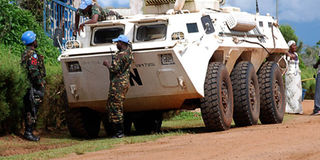UN says Tanzanian, DR Congo troops colluding with rebels, cites confusion

Soldiers of the United Nations Organisation Stabilisation Mission in the Democratic Republic of Congo (Monusco) stand near a UN armoured vehicle in Beni on October 23, 2014. A confidential report by a UN group of experts obtained on Friday depicts instances of apparent collusion with enemy or outside forces on the part of Tanzanian peacekeepers and government troops in the Democratic Republic of Congo. AFP PHOTO | ALAIN WANDIMOYI
What you need to know:
- In an incident last May in North Kivu, the group recounts, two Tanzanian peacekeepers were killed and 26 wounded in an attack initially thought to have been carried out by the Alliance of Democratic Forces, a set of fighters from Uganda.
- Eyewitnesses told the group of experts that Fardc soldiers from the 31st brigade had opened fire on the Tanzanians after two civilians had indicated that the Tanzanians were providing supplies to their supposed enemies, the ADF.
- The experts say in their report that they cannot be certain why the Tanzanian peacekeepers were meeting with ADF elements.
NEW YORK/UNITED NATIONS
A confidential report by a United Nations group of experts obtained on Friday depicts instances of apparent collusion with enemy or outside forces on the part of Tanzanian peacekeepers and government troops in the Democratic Republic of Congo.
In an incident last May in North Kivu, the group recounts, two Tanzanian peacekeepers were killed and 26 wounded in an attack initially thought to have been carried out by the Alliance of Democratic Forces, a set of fighters from Uganda.
The ADF is one of the main rebel groups in eastern DRC that terrorises civilians and has been targeted for elimination by UN peacekeepers and the Congolese government army.
A subsequent investigation by the UN Mission in the DRC, known as Monusco, revealed, however, that the attack on the Tanzanians was actually the work of the Congolese government army, identified by the French acronym Fardc.
Eyewitnesses told the group of experts that Fardc soldiers from the 31st brigade had opened fire on the Tanzanians after two civilians had indicated that the Tanzanians were providing supplies to their supposed enemies, the ADF.
The experts say in their report that they cannot be certain why the Tanzanian peacekeepers were meeting with ADF elements.
But the group adds that it “can conclude that the Tanzanian peacekeepers who were present during the attack provided untruthful testimonies to both the group and Monusco.”
APPARENT CONFUSION
In another incident of confusion and possible collusion last November, the ADF and a second armed group unidentified in the UN report attacked and overran a Fardc camp in North Kivu.
Fardc commanders asked for help from a Malawian detachment of UN peacekeepers as the attack was under way, the report says. But the Fardc officers did not subsequently inform the Malawian unit that the camp had been captured by the ADF.
When the Malawians arrived, they saw men in the camp wearing Fardc uniforms. The Malawians assumed these were friendly elements, but the men shot at the Malawian soldiers, killing one of them, the group reports.
The UN experts add that the Fardc commander of the camp knew in advance that an attack would occur.
A DRC military prosecutor in Beni in North Kivu has opened a case against the commander and has further requested that the head of Fardc operations in the region, Gen Mbangu, be handed over for questioning.
Fardc involvement in attempted arms smuggling to a rebel group in Burundi is also described in the report.
Two Congolese army officers were arrested in October and November of last year in Goma, North Kivu, while trying, with five accomplices, to move DRC weaponry into other countries.
Some of those apprehended told the group of experts that the weapons were intended for an anti-government unit inside Burundi.
One of the two Fardc officers was found to be selling arms from storage areas maintained by the DRC army, the report notes.




